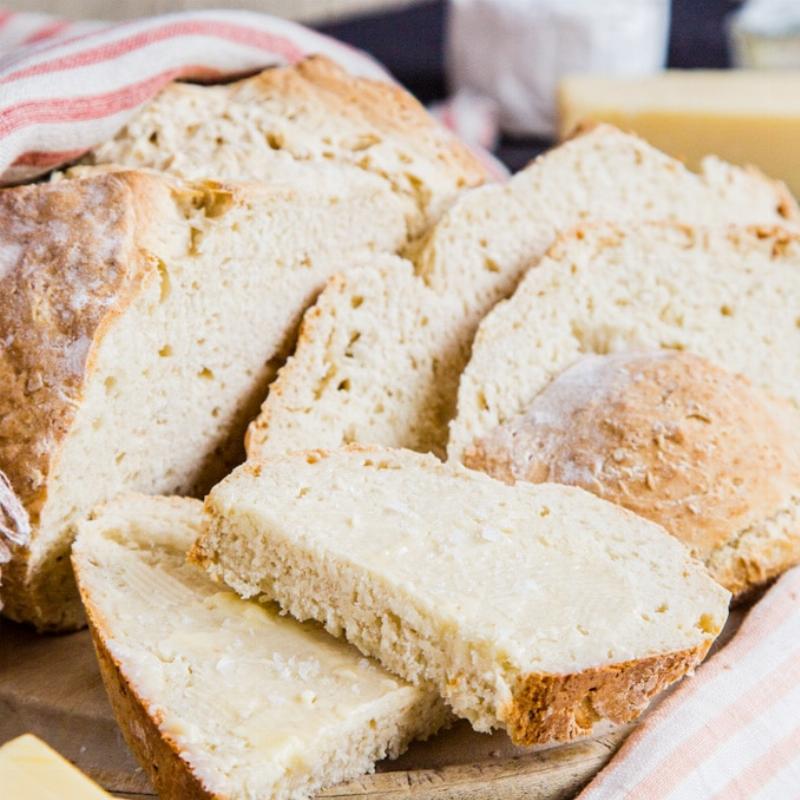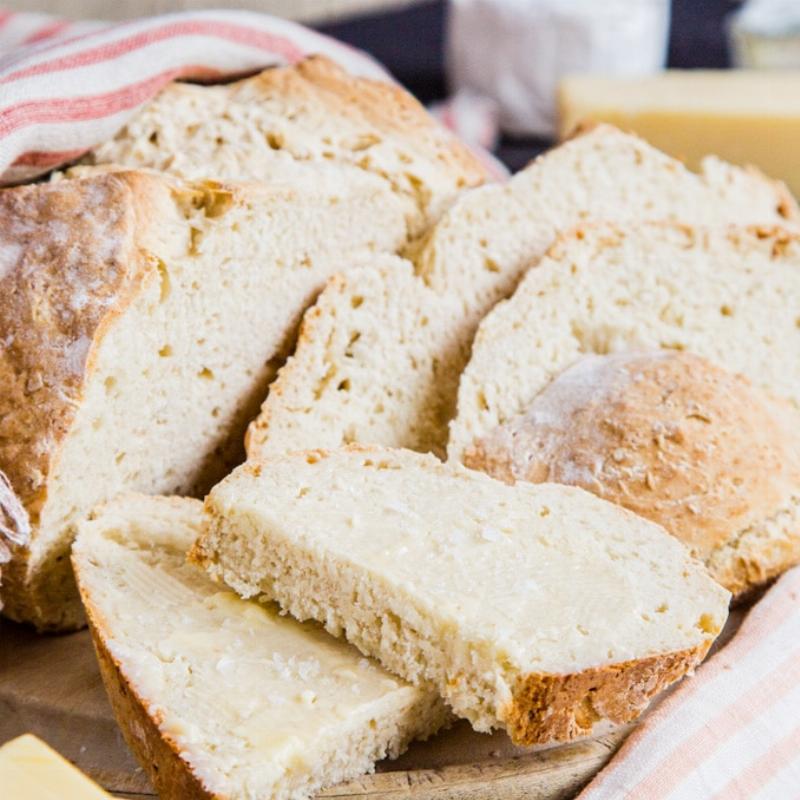Making delicious homemade bread doesn’t have to involve hours of kneading and waiting for yeast to rise. This Simple No-yeast Bread Recipe is perfect for those who crave freshly baked bread without the fuss. It relies on readily available ingredients and a simple method that even novice bakers can master. Get ready to enjoy the warm, comforting aroma of freshly baked bread wafting through your kitchen!
Table Of Contents
Quick and Easy No-Yeast Bread: A Baker’s Delight
This simple no-yeast bread is incredibly versatile. Enjoy it warm with butter and jam for breakfast, use it for sandwiches at lunch, or serve it alongside soups and stews for dinner. It’s a true crowd-pleaser, offering the satisfying taste of homemade bread without the lengthy yeast-based process. With just a few pantry staples and a little bit of effort, you can have a loaf of this wonderful bread gracing your table in no time. Similar to simple baking recipes, this recipe emphasizes ease and accessibility.
This simple no-yeast bread recipe utilizes baking soda and baking powder as leavening agents, eliminating the need for yeast activation. This makes it a quick bread, meaning it can be mixed and baked immediately. The resulting loaf has a slightly denser crumb than yeast bread but retains a lovely soft texture. Its subtle, slightly tangy flavor makes it a perfect accompaniment to a variety of dishes.
 Ingredients for No-Yeast Bread
Ingredients for No-Yeast Bread
Step-by-Step Guide to Baking Simple No-Yeast Bread
This easy-to-follow guide breaks down the process of making no-yeast bread into simple, manageable steps:
- Preheat your oven to 375°F (190°C). Grease and flour a loaf pan. This will prevent the bread from sticking and ensure easy removal after baking.
- In a large bowl, whisk together the dry ingredients: 3 cups all-purpose flour, 1 teaspoon baking soda, 1 teaspoon baking powder, 1 teaspoon salt, and 2 tablespoons sugar. Whisking thoroughly ensures even distribution of the leavening agents for a uniform rise.
- In a separate bowl, combine the wet ingredients: 1 ½ cups milk, 2 tablespoons oil (vegetable or melted coconut oil), and 1 tablespoon vinegar (white or apple cider). The vinegar reacts with the baking soda, creating additional lift and a tender crumb.
- Pour the wet ingredients into the dry ingredients and stir gently until just combined. Be careful not to overmix, as this can result in a tough bread.
- Pour the batter into the prepared loaf pan and bake for 50-60 minutes, or until a wooden skewer inserted into the center comes out clean.
Tips and Tricks for Perfect No-Yeast Bread Every Time
Mastering this simple no-yeast bread recipe is easy with these helpful tips:
- Don’t overmix the batter: Overmixing develops gluten, leading to a dense and chewy texture. Mix until just combined for a light and airy bread.
- Adjust the baking time: Ovens vary, so adjust the baking time as needed. Start checking for doneness at 50 minutes.
- Add flavor variations: Incorporate herbs, spices, cheeses, or even chopped nuts into the dough for added flavor and texture.
- Proper storage: Once cooled, store the bread in an airtight container at room temperature for up to 3 days or freeze for longer storage.
If you enjoy simple baking projects like this one, you might also be interested in exploring our collection of best scones recipes. Scones, like this no-yeast bread, offer the satisfaction of homemade baking without complex techniques.
 Freshly Baked No-Yeast Bread
Freshly Baked No-Yeast Bread
“No-yeast bread is a lifesaver for busy weeknights,” shares renowned baker, Amelia Dupont. “It’s quick, simple, and delivers that comforting homemade flavor we all crave.” Its simplicity doesn’t compromise its versatility.
Why Choose a No-Yeast Bread Recipe?
What makes a simple no-yeast bread recipe so appealing? Let’s explore the key advantages:
- Speed and Convenience: Perfect for when you need bread quickly, without the wait for yeast activation. It’s a fantastic option for last-minute baking needs.
- Simplicity: The straightforward method makes it ideal for beginner bakers. This no-yeast approach eliminates the potential pitfalls of working with yeast.
- Accessibility: The recipe relies on pantry staples, making it a convenient and budget-friendly choice. These ingredients are generally readily available.
“Baking should be accessible to everyone,” explains culinary instructor, Michael Carter. “No-yeast bread empowers anyone to experience the joy of creating fresh, homemade bread without intimidation.”
This simple no-yeast bread is truly a testament to the fact that delicious homemade bread doesn’t have to be complicated. It’s a testament to the beauty of simple baking. For a similarly straightforward baking experience, you might also appreciate our selection of easy scones recipes.
Conclusion: Enjoy the Simple Pleasure of Homemade No-Yeast Bread
This simple no-yeast bread recipe proves that baking delicious, homemade bread can be both quick and easy. Whether you’re a seasoned baker or just starting your baking journey, this recipe is a must-try. So, gather your ingredients and experience the satisfaction of creating a warm, fragrant loaf that will impress your family and friends. Embrace the simplicity and savor the delicious results! For those interested in exploring other simple bread options, our easy cornbread recipe is another excellent choice.
 Sliced No-Yeast Bread
Sliced No-Yeast Bread
FAQs about Simple No-Yeast Bread
1. Can I use whole wheat flour in this recipe?
Yes, you can substitute up to 50% of the all-purpose flour with whole wheat flour. This will result in a denser and slightly nuttier loaf.
2. Can I add other ingredients to the bread?
Absolutely! Cheese, herbs, spices, and nuts are all great additions to this versatile recipe. Get creative and personalize your loaf.
3. How should I store the bread?
Store the cooled bread in an airtight container at room temperature for up to 3 days. You can also freeze slices for longer storage. Proper storage helps maintain freshness.
4. Can I make this bread ahead of time?
While it’s best enjoyed fresh, you can bake the bread a day ahead and reheat it briefly before serving. Reheating restores warmth and texture.
5. My bread didn’t rise as much as I expected. What happened?
This could be due to old baking powder or soda. Make sure your leavening agents are fresh for optimal rise.
6. Can I use buttermilk instead of regular milk?
Yes, buttermilk will add a delightful tanginess to the bread. Buttermilk can enhance flavor and texture.
7. What other quick bread recipes can I try?
For other quick bread recipes, explore our collection of classic French baking recipes which also offer some no-yeast options.

Pingback: Quick White Bread No Knead: The Easiest Loaf You'll Ever Bake - Bestbaking Recipes